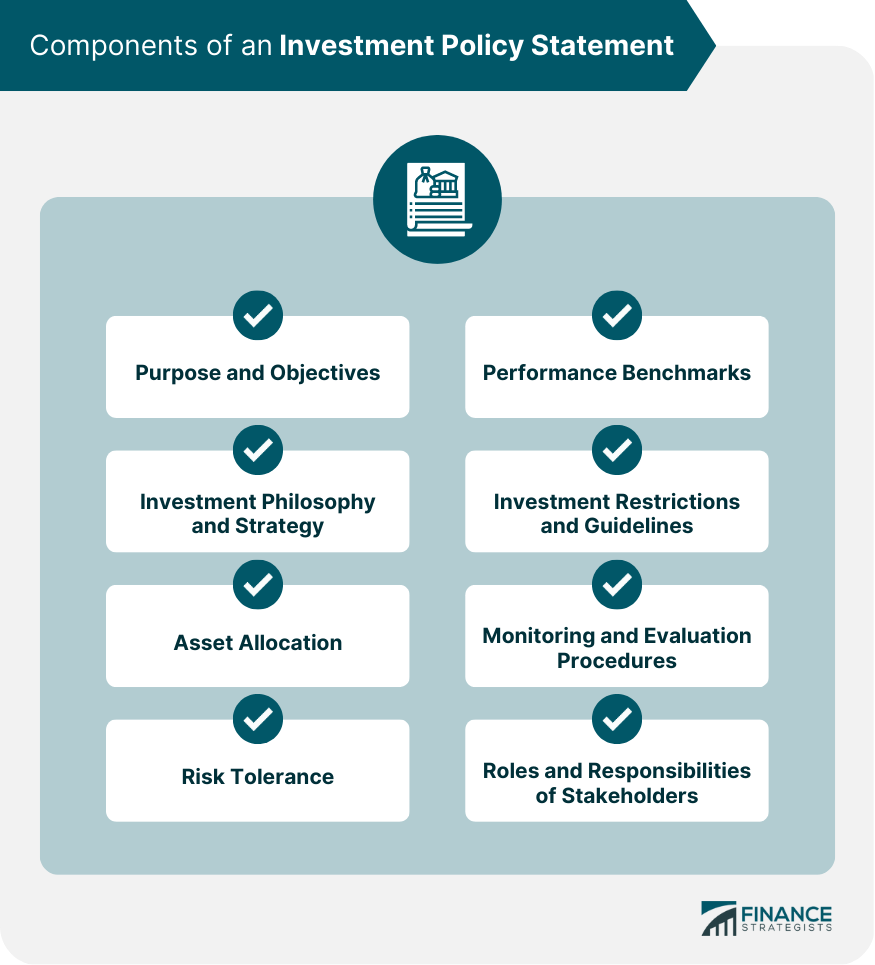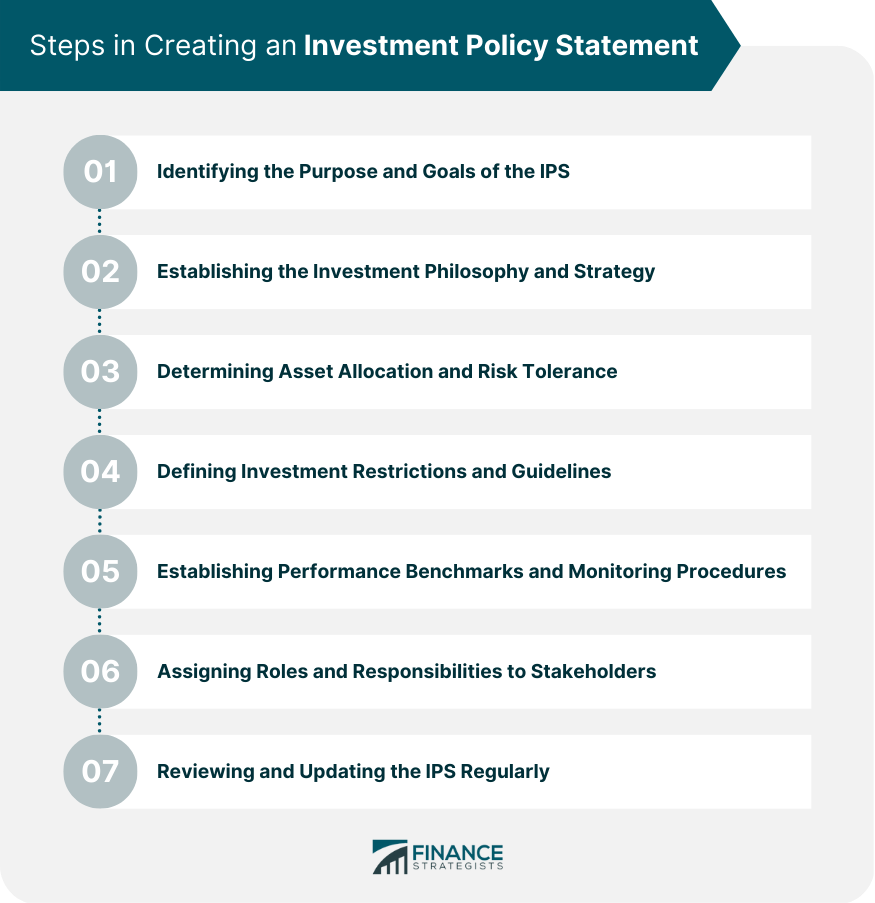An Investment Policy Statement (IPS) is a document that outlines the investment objectives, strategies, and guidelines of an investor or organization. It is a critical tool in investment decision-making, providing clarity and transparency in the investment process. The IPS serves as a blueprint for investment decisions, providing guidance to investment professionals and stakeholders. An effective IPS should include the following components: The IPS should clearly define the purpose of the investment portfolio and the objectives it aims to achieve. It should articulate the investor's or organization's goals, expectations, and risk tolerance. The IPS should define the investment philosophy and strategy that will guide investment decisions. It should specify the types of assets and securities to be invested in, the expected return on investment, and the time horizon of the investment. The IPS should specify the asset allocation strategy, which defines the percentage of the portfolio allocated to different asset classes such as stocks, bonds, and alternative investments. Asset allocation is a critical component of portfolio construction, as it determines the risk and return characteristics of the portfolio. The IPS should define the investor or organization's risk tolerance level, which is the maximum amount of risk they are willing to accept. Risk tolerance is an essential component of investment decision-making, as it determines the type of assets and securities to be invested in. The IPS should define the performance benchmarks against which the investment portfolio's performance will be measured. Performance benchmarks provide a means of evaluating the effectiveness of the investment strategy and determining whether it is achieving the desired results. The IPS should establish the investment restrictions and guidelines that the investment professionals and stakeholders must follow. These restrictions may include ethical considerations, legal constraints, and investment guidelines that limit the types of securities and assets that can be invested in. The IPS should specify the procedures for monitoring and evaluating the investment portfolio's performance. It should define the frequency of portfolio reviews, the methods used to evaluate portfolio performance, and the steps to be taken if the portfolio does not meet its performance targets. The IPS should specify the roles and responsibilities of investment professionals and stakeholders, including portfolio managers, investment advisors, and board members. It should define the decision-making process and the level of authority of each stakeholder. To create an effective IPS, the following steps should be followed: The first step in creating an IPS is to identify the purpose and goals of the investment portfolio. This may include defining the target return on investment, the time horizon of the investment, and the risk tolerance level. The next step is establishing the investment philosophy and strategy to guide investment decisions. This may involve defining the asset classes to be invested in, the expected return on investment, and the time horizon of the investment. The investment philosophy and strategy should be aligned with the purpose and goals of the IPS. The IPS should specify the asset allocation strategy, which defines the percentage of the portfolio allocated to different asset classes. The asset allocation strategy should be based on the investor or organization's risk tolerance level, investment goals, and time horizon. The IPS should establish investment restrictions and guidelines that investment professionals and stakeholders must follow. These restrictions may include ethical considerations, legal constraints, and investment guidelines that limit the types of securities and assets that can be invested in. The IPS should define the performance benchmarks against which the investment portfolio's performance will be measured. It should specify the methods used to evaluate portfolio performance, the frequency of portfolio reviews, and the steps to be taken if the portfolio does not meet its performance targets. The IPS should specify the roles and responsibilities of investment professionals and stakeholders, including portfolio managers, investment advisors, and board members. It should define the decision-making process and each stakeholder's authority level. The IPS should be reviewed and updated regularly to ensure that it remains relevant and effective. Changes in investment goals, market conditions, and risk tolerance levels may require updates to the IPS. Sample IPS templates are available for different types of investors and organizations. These templates can be used as a starting point in creating an IPS that meets the unique needs of the investor or organization. Additionally, case studies of successful IPS implementation and outcomes can provide insight into the benefits of an effective IPS. An effective IPS provides the following benefits: Clarity and Transparency in Investment Decision-Making: The IPS provides clarity and transparency in the investment process, making it easier for stakeholders to understand the investment strategy and decision-making process. Consistency in Investment Strategy: The IPS provides a consistent framework for investment decision-making, ensuring that investment decisions are made in a systematic and consistent manner. Risk Management and Mitigation: The IPS helps to manage and mitigate investment risks by defining the risk tolerance level, establishing asset allocation guidelines, and setting investment restrictions. Accountability and Compliance: The IPS provides accountability and compliance with legal, ethical, and regulatory requirements. Improved Investment Performance: The IPS provides a systematic and disciplined approach to investment decision-making, which can lead to improved investment performance over time. Failure to accurately assess an investor's risk tolerance can lead to an investment strategy that is either too conservative or too aggressive, potentially hindering the achievement of financial goals. Focusing too much on short-term performance can encourage investment managers to make decisions that prioritize immediate gains over long-term objectives, potentially jeopardizing the investor's financial goals. Adhering to overly rigid investment strategies can limit an investor's ability to capitalize on emerging opportunities or adapt to changing market conditions, potentially reducing portfolio returns. Communication with stakeholders can lead to better understandings, misaligned expectations, and a lack of trust between the investor and investment manager. With regular monitoring and review of the IPS, the document may become updated or misaligned with the investor's objectives, limiting its effectiveness as a guiding tool for investment management. Investor profiling should encompass all relevant aspects of the investor's financial situation, risk tolerance, time horizon, and objectives, providing a solid foundation for the investment strategy. Using clear and concise language in the IPS makes it easier for stakeholders to understand the document. It ensures that everyone is on the same page regarding the investment strategy and guidelines. Identifying and addressing all relevant investment constraints and considerations, such as liquidity needs, legal and regulatory restrictions, and tax implications, helps create a more effective and tailored investment strategy. Regularly reviewing and updating the IPS ensures that it remains relevant and effective in guiding investment management, and adapting to changes in investor circumstances or market conditions. Maintaining open lines of communication with stakeholders fosters trust and ensures that everyone remains aligned with the investor's goals and objectives. Educating stakeholders about the IPS can enhance their understanding of the investment strategy and promote more active engagement in the investment process. This education can include: Offering training sessions or workshops on the IPS can help stakeholders better understand the document's purpose, components, and importance in guiding investment management. Ensuring that the IPS is easily accessible to all relevant stakeholders, such as by providing a digital copy or posting it on an internal website, can encourage greater familiarity with the document and its contents. Fostering an open dialogue around the IPS, its guidelines, and the investment strategy can help stakeholders ask questions, voice concerns, and provide input, promoting a more collaborative and transparent investment process. An Investment Policy Statement is essential for investors and organizations to guide their investment decisions. Its components include purpose and objectives, investment philosophy and strategy, asset allocation, risk tolerance, performance benchmarks, investment restrictions and guidelines, monitoring and evaluation procedures, and roles and responsibilities of stakeholders. Creating an effective IPS involves defining its purpose, establishing investment strategy, determining asset allocation and risk tolerance, defining investment guidelines, setting performance benchmarks, assigning roles and responsibilities, and regularly reviewing and updating it. The benefits of an effective IPS include clarity and transparency in investment decision-making, consistency in investment strategy, risk management and mitigation, accountability, compliance, and improved investment performance. If you are an investor or organization seeking to create an effective IPS, it is recommended to hire the services of a wealth management professional. A wealth management professional can help you create an IPS tailored to your specific needs and goals and provide ongoing support and guidance to help you achieve your investment objectives.What Is an Investment Policy Statement (IPS)?
Components of an Investment Policy Statement

Purpose and Objectives
Investment Philosophy and Strategy
Asset Allocation
Risk Tolerance
Performance Benchmarks
Investment Restrictions and Guidelines
Monitoring and Evaluation Procedures
Roles and Responsibilities of Stakeholders
Creating an Investment Policy Statement

Identifying the Purpose and Goals of the IPS
Establishing the Investment Philosophy and Strategy
Determining Asset Allocation and Risk Tolerance
Defining Investment Restrictions and Guidelines
Establishing Performance Benchmarks and Monitoring Procedures
Assigning Roles and Responsibilities to Stakeholders
Reviewing and Updating the IPS Regularly
Examples of Investment Policy Statements
Benefits of an Investment Policy Statement
It provides a clear framework for decision-making, ensuring that investment decisions are made in compliance with applicable laws and regulations.Common Challenges in Investment Policy Statement Development
Inadequate Risk Assessment
Overemphasis on Short-Term Performance
Rigid Investment Strategies
Lack of Clear Communication With Stakeholders
Insufficient Monitoring and Review Processes
Best Practices for Investment Policy Statement Development
Comprehensive Investor Profiling
Clear and Concise Language
Inclusion of Relevant Constraints and Considerations
Periodic Reviews and Updates
Active Communication With Stakeholders
Educating Stakeholders
Providing Training
Making It Accessible
Encouraging Open Dialogue
The Bottom Line
Investment Policy Statement (IPS) FAQs
An Investment Policy Statement (IPS) is a document that outlines the investment objectives, strategies, and guidelines of an investor or organization. It provides clarity and transparency in the investment process and serves as a blueprint for investment decisions.
An Investment Policy Statement is important because it provides clarity and transparency in investment decision-making, ensures consistency in investment strategy, helps to manage and mitigate investment risks, provides accountability and compliance with legal, ethical, and regulatory requirements, and can lead to improved investment performance over time.
The components of an Investment Policy Statement include purpose and objectives, investment philosophy and strategy, asset allocation, risk tolerance, performance benchmarks, investment restrictions and guidelines, monitoring and evaluation procedures, and roles and responsibilities of stakeholders.
To create an effective Investment Policy Statement, investors and organizations should follow steps such as identifying the purpose and goals of the IPS, establishing the investment philosophy and strategy, determining asset allocation and risk tolerance, defining investment restrictions and guidelines, establishing performance benchmarks and monitoring procedures, assigning roles and responsibilities to stakeholders, and regularly reviewing and updating the IPS.
Yes, it is recommended for investors and organizations to seek professional help in creating an Investment Policy Statement. A wealth management professional can help create an IPS that is tailored to specific needs and goals and provide ongoing support and guidance to achieve investment objectives.
True Tamplin is a published author, public speaker, CEO of UpDigital, and founder of Finance Strategists.
True is a Certified Educator in Personal Finance (CEPF®), author of The Handy Financial Ratios Guide, a member of the Society for Advancing Business Editing and Writing, contributes to his financial education site, Finance Strategists, and has spoken to various financial communities such as the CFA Institute, as well as university students like his Alma mater, Biola University, where he received a bachelor of science in business and data analytics.
To learn more about True, visit his personal website or view his author profiles on Amazon, Nasdaq and Forbes.















